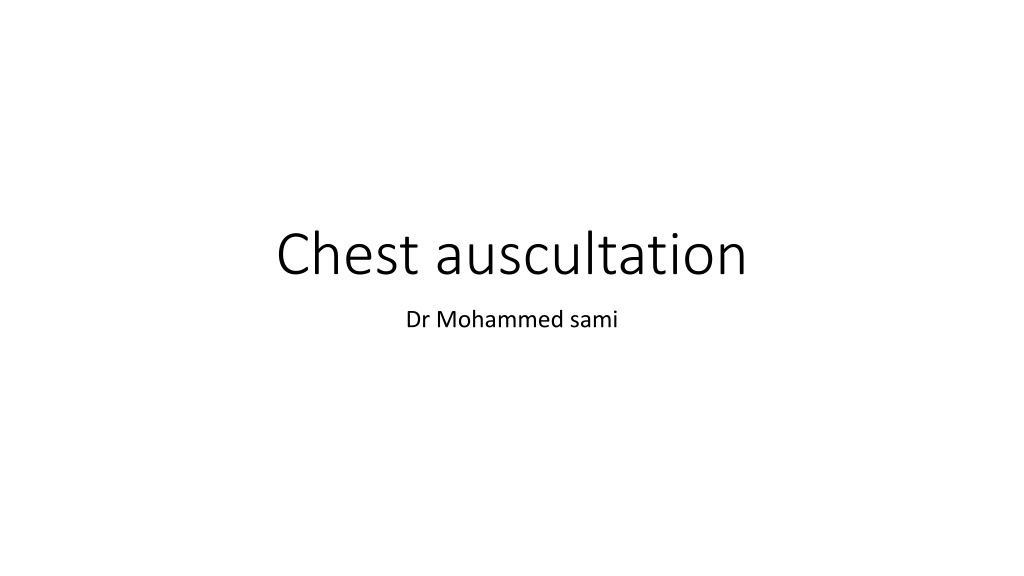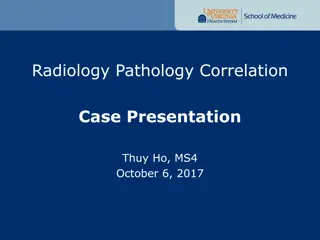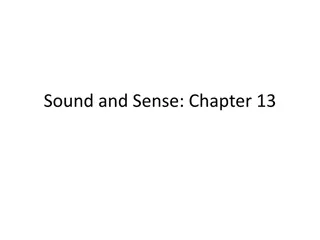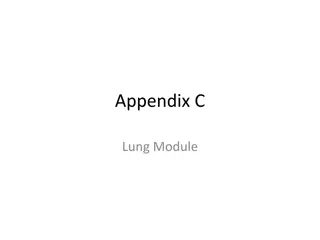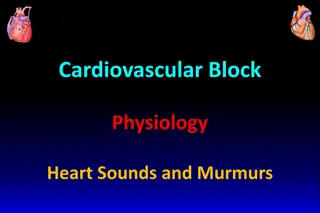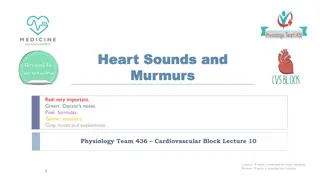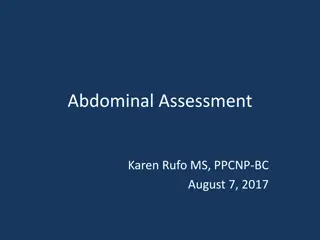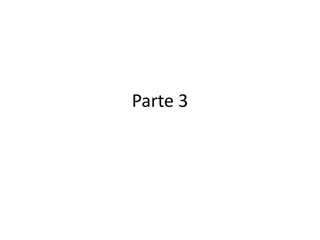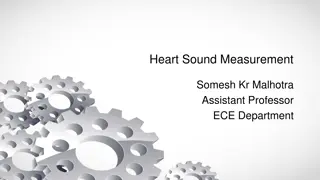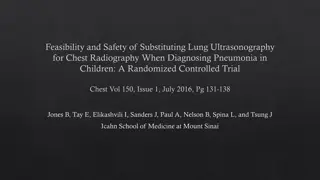Understanding Lung Sounds and Auscultation Techniques
Exploring the world of chest auscultation with Dr. Mohammed Sami, this guide provides insights into how to listen to lung sounds, where to listen, what to listen for, and the use of a stethoscope. Learn about different lung areas, sound characteristics, airflow patterns, and the mechanics behind breath sounds. Enhance your auscultation skills by understanding laminar airflow, sound characteristics, and frequency measurements.
Download Presentation

Please find below an Image/Link to download the presentation.
The content on the website is provided AS IS for your information and personal use only. It may not be sold, licensed, or shared on other websites without obtaining consent from the author. Download presentation by click this link. If you encounter any issues during the download, it is possible that the publisher has removed the file from their server.
E N D
Presentation Transcript
Chest auscultation Dr Mohammed sami
Listening to lung sounds How? Where? What are you listening for ?
Imagine what you are hearing
Where do you listen There at least 4 separate areas on both sides of the body, top & bottom, front & back, right & left. Each area should be listened to in both inspiration & exhalation phases
Listening Be sure to listen to each full cycle of inspiration and expiration before moving your stethoscope You should hear breath sounds over all lung tissue, and the quality of the breath sounds should be similar as you listen from side to side.
Use of the Stethoscope The diaphragm- most suitable for listening to high-pitched sounds & murmurs. The bell- is best suited for low-pitched sounds & murmurs.
Laminar airflow In the small airways and respiratory bronchioles, airflow is slow and linear. This is called laminar airflow. No abrupt changes in pressure or airway wall movements occur to generate sound. Consequently, air movement in these areas produces no sound. Breath sounds P Comparing airflow patterns The following illustrations show the three primary airflow patterns affecting airway dynamics. Breath sounds result as air moves through the airways of the respiratory tract. The diameter of the airway, pressure changes in the airway, and vibrations of solid tissue all affect the sound produced. Turbulent airflow Circular airflow (vortices) Laminar airflow Understanding sound Mechanical vibrations, sound damping, and impedance matching also affect the sounds heard during auscultation. Mechanical vibrations The mechanical vibrations of solid tissue also produce breath sounds. The speed at which these vibrations travel depends on whether they're traveling through air, fluid, or tissue. The frequency, intensity, and duration of these sounds can be measured. Frequency
Sound characteristics Frequency measured in hertz refers to the number of vibrations occurring per unit of time. Different frequencies produce the different sounds heard during auscultation. the term pitch is used to describe sound frequency. High-pitched sounds have higher frequencies; low-pitched sounds have lower frequencies Intensity : the loudness or softness of the vibrations that produce breath sounds. Intensity can be measured electronically by recording amplitude. Several factors affect intensity, including the type of structure that's vibrating as well as the distance and type of substance through which the vibrations must travel. Duration the vibrations that produce breath sounds can be measured in milliseconds. However, during auscultation, you'll note sounds as being long or short and as continuous or discontinuous.
When its not normal Diminished or hard-to-hear lung sounds are most common with thick chest walls (in either muscular or obese patients), or when the patient is not taking deep breaths. However, diminished breath sounds can also be associated with disease. Absent sounds this can result from airway obstruction, with collapse of lung tissue (such as pneumothorax)
Wheezes Wheezes Wheezes are continuous sounds caused by air moving through constricted airways. Airways can be narrowed by a number of causes: the bronchial constriction that accompanies asthma, bronchial inflammation, mucus accumulation or mucous plugs, or tumors. Wheezes can be: high-pitched, which is common with asthma low-pitched with almost a snoring quality. Low-pitched wheezes are sometimes called rhonchi. Mild wheezing is often limited to the expiratory phase of respiration, while more severe wheezing can be heard throughout the respiratory cycle. Both wheezing and crackles may clear with coughing, so ask the patient to take a deep breath and cough a couple of times, then listen again
Stridor is a high-pitched sound typically generated when a larger airway is blocked by a foreign body, severe inflammation, or a mass. A friction rub may result when the pleural membranes covering the lungs and lining the thoracic cavity are inflamed. A friction rub is a scratching or squeaking sound that persists throughout the respiratory cycle and does not clear with coughing. The characteristics of a friction rub can be imitated by pressing the palm of one hand over the ear and then lightly and slowly rubbing the back of the hand with the fingers of the other hand.
Vesicular The vesicular breath sound is believed to be the result of movement of air in the bronchioles and alveoli. Variously described as sighing or a gentle rustling,vesicular breathing is a soft, relatively low-pitched sound. The normal vesicular respiration is longer in the inspiratory than in the expiratory phase by a ratio of approximately 5:2.
Vesicular It should be emphasized that expiration as heard in vesicular breathing is not actually shorter than inspiration --only that much of expiration is not audible. Inspiration is higher in pitch and louder than expiration. In fact, expiration occasionally may be inaudible. Vesicular breath sounds heard from normally over most of the lungs.
Bronchovesicular In certain areas where the trachea and major bronchi are in proximity to the chest wall,there is heard a mixture of both tracheobronchial and vesicular elements that is termed bronchovesicular breath sound.
Bronchovesicular This type of breath sound is heard normally on each side of the sternum in the first and second interspaces,between the scapulae, and over the apices anteriorly and posteriorly,but are more prominent on the right than on the left. When heard in other locations, brochovesicular breathing is abnormal and is indicative of some disease process.
Vesicular and bronchovesicular are the two types of breath sounds heard normally over the lungs.
Bronchial breathing Bronchial breath sounds are in general higher in pitch than vesicular or bronchovesicular sounds. Expiration usually inspiration in length. longer than
Bronchial breathing Bronchial breathing is not normally heard over the lungs. Therefore,its presence over the indicates disease. It occurs only consolidation,an increased conducting mechanism. lungs always with pulmonary
Bronchovesicular breathing Bronchovesicular breathing is abnormal when heard in any area of the lungs that normally have vesicular breath sounds. An admixture of consolidated and aerated lung produces a mixture of bronchial and vesicular breathing--bronchovesicular breath sounds.
Elongated expiratory breath sound Occurs because of partial obstruction,spasm or stricture of the lower respiratory tract, happening in bronchitis,bronchial asthma etc. Because of lowering elasticity of pulmonary tissue,happening in COPD etc.
Decreased or absent breath sounds l. fluid in the pleural space. 2.air in the pleural space(pneumothorax)causes a diminution in the breath sounds. 3. If there is thickened pleura caused by fibrosis -which may follow effusion,hemothorax, and empyema-or by actual tumor involvement of the pleura,decrease in breath sounds is noted
Decreased or absent breath sounds 4. Breath sounds are commonly decreased in emphysema because of the decreased air velocity and sound conduction. 5. Breath sounds are markedly diminished or absent in complete bronchial obstruction. 6.If there is definite decrease in expansion, such as that commonly noted in painful pleurisy with its attendant shallow breathing, the breath sounds are diminished because of the decreased ventilation.
Rales They result from the passage of air through secretions in the respiratory tract and from reinflation of the alveoli and bronchioles, the walls of which have become adherent as the result of moisture. Rales,therefore,are produced by air flow plus abnormal moisture.
Rhonchi Rhonchi are continuous sounds produced by the passage of air through the trachea, bronchi, and bronchioles that have been narrowed, irrespective of the cause. As long as air passes the obstruction, the sound will be produced.
If you hear diminished but normal breath sounds in both lungs, the patient may have emphysema, atelectasis, severe broncho-spasm, or shallow breathing. If you hear breath sounds in one lung only, the patient may have pleural effusion, pneumothorax, a tumor, or mucus plugs in the airways. In such cases, the doctor may order pulmonary function tests to further assess the patient's condition. P (See Interpreting pulmonary function test results, page 40.) Characteristics of breath sounds Use this chart to help you recognize patterns of breath sounds by their intensity, pitch, and duration of inspiratory and expiratory phases. Note that the thickness of the bars indicates intensity; the steeper an incline, the higher the pitch. Intensity of expiratory sound Pitch of expiratory sound Duration of sounds Location where normally heard Breath sound Inspiratory sounds last longer than expiratory ones. Soft Relatively low Over most of the lungs Inspiratory and expiratory sounds are about equal. Intermediate Intermediate Commonly in the first and second interspaces anteriorly and between the scapulae Expiratory sounds last longer than inspiratory ones. Loud Relatively high Over the manubrium, if heard at all Inspiratory and expiratory sounds are about equal. Very loud Relatively high Over the trachea in the neck Sounding board
Auscultation Auscultation finding in pneumonia finding in pneumonia In the early stages of lobar pneumonia, the breath sounds may be diminished or suppressed. Fine crepitant rales may be heard. With the development of frank consolidation, the crepitant rales disappears, the breath sounds become bronchial .
Auscultation Auscultation Pulmonary emphysema Pulmonary emphysema On auscultation the breath sounds are vesicular and generally diminished in intensity or almost inaudible. Expiration is commonly prolonged. Rhonchi are normally widespread, but may be most marked at the bases of the lung.
Pulmonary atelectasis occurs when an area of lung tissue is not ventilated. The signs and symptoms that follow depend upon the amount of lung tissue involved and vary from an asymptomatic shadow on an X-ray to acute respiratory distress. When a sufficient amount of lung is involved, there are signs of respiratory distress The breath sounds are usually absent over the affected area.
